Bosch 11224VSRC User Manual
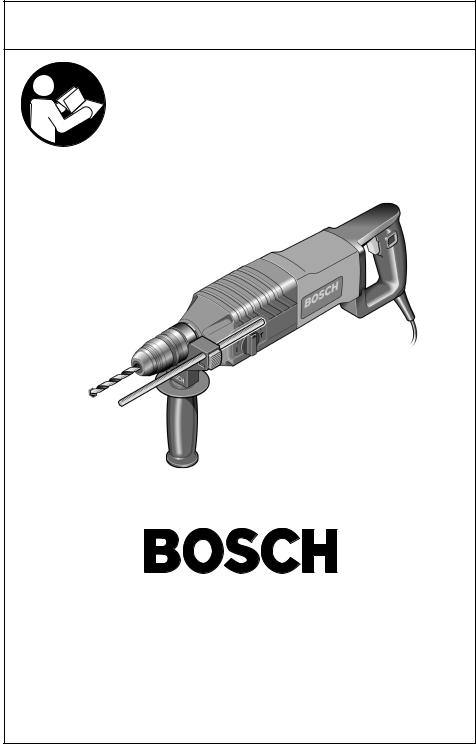
IMPORTANT: |
IMPORTANT : |
IMPORTANTE: |
Read Before Using |
Lire avant usage |
Leer antes de usar |
Operating/Safety Instructions
Consignes de fonctionnement/sécurité
Instrucciones de funcionamiento y seguridad
11224VSRC
Consumer Information
Renseignement des consommateurs
Información para el consumidor
Toll Free Number: |
Appel gratuit : |
Número de teléfono gratuito: |
1-877-BOSCH99 (1-877-267-2499) http://www.boschtools.com |
||
|
|
|
For English |
Parlez-vous français? |
¿Habla español? |
See page 2 |
Voir page 11 |
Ver página 20 |

Power Tool Safety Rules
! WARNING Read and understand all instructions. Failure to follow all instructions listed below, may result in electric shock, fire and/or serious personal injury.
SAVE THESE INSTRUCTIONS
Work Area
Keep your work area clean and well lit.
Cluttered benches and dark areas invite accidents.
Do not operate power tools in explosive atmospheres, such as in the presence of flammable liquids, gases, or dust. Power tools create sparks which may ignite the dust or fumes.
Keep by-standers, children, and visitors away while operating a power tool.
Distractions can cause you to lose control.
Electrical Safety
Double Insulated tools are equipped with a polarized plug (one blade is wider than the other.) This plug will fit in a polarized outlet only one way. If the plug does not fit fully in the outlet, reverse the plug. If it still does not fit, contact a qualified electrician to install a polarized outlet. Do not change the plug in any way. Double Insulation



 eliminates the need for the three wire grounded power cord and grounded power supply system. Before plugging in the tool, be certain the outlet voltage supplied is within the voltage marked on the nameplate. Do not use “AC only” rated tools with a DC power supply.
eliminates the need for the three wire grounded power cord and grounded power supply system. Before plugging in the tool, be certain the outlet voltage supplied is within the voltage marked on the nameplate. Do not use “AC only” rated tools with a DC power supply.
Avoid body contact with grounded surfaces such as pipes, radiators, ranges and refrigerators. There is an increased risk of electric shock if your body is grounded. If operating the power tool in damp locations is unavoidable, a Ground Fault Circuit Interrupter must be used to supply the power to your tool. Electrician’s rubber gloves and footwear will further enhance your personal safety.
Don't expose power tools to rain or wet conditions. Water entering a power tool will increase the risk of electric shock.
Do not abuse the cord. Never use the cord to carry the tools or pull the plug from an outlet. Keep cord away from heat, oil, sharp edges or moving parts. Replace damaged cords immediately. Damaged cords increase the risk of electric shock.
When operating a power tool outside, use an outdoor extension cord marked "W-A" or "W." These cords are rated for outdoor use and reduce the risk of electric shock. Refer to “Recommended sizes of Extension Cords” in the Accessory section of this manual.
Personal Safety
Stay alert, watch what you are doing and use common sense when operating a power tool. Do not use tool while tired or under the influence of drugs, alcohol, or medication. A moment of inattention while operating power tools may result in serious personal injury.
Dress properly. Do not wear loose clothing or jewelry. Contain long hair. Keep your hair, clothing, and gloves away from moving parts. Loose clothes, jewelry, or long hair can be caught in moving parts. Keep handles dry, clean and free from oil and grease.
Avoid accidental starting. Be sure switch is “OFF” before plugging in. Carrying tools with your finger on the switch or plugging in tools that have the switch “ON” invites accidents.
Remove adjusting keys or wrenches before turning the tool “ON”. A wrench or a key that is left attached to a rotating part of the tool may result in personal injury.
Do not overreach. Keep proper footing and balance at all times. Proper footing and balance enables better control of the tool in unexpected situations.
Use safety equipment. Always wear eye protection. Dust mask, non-skid safety shoes, hard hat, or hearing protection must be used for appropriate conditions.
Tool Use and Care
Use clamps or other practical way to secure and support the workpiece to a stable platform. Holding the work by hand or against your body is unstable and may lead to loss of control.
Do not force tool. Use the correct tool for your application. The correct tool will do the
-2-

job better and safer at the rate for which it is designed.
Do not use tool if switch does not turn it “ON” or “OFF”. Any tool that cannot be controlled with the switch is dangerous and must be repaired.
Disconnect the plug from the power source before making any adjustments, changing accessories, or storing the tool. Such preventive safety measures reduce the risk of starting the tool accidentally.
Store idle tools out of reach of children and other untrained persons. Tools are dangerous in the hands of untrained users.
Maintain tools with care. Keep cutting tools sharp and clean. Properly maintained tools, with sharp cutting edges are less likely to bind and are easier to control. Any alteration or modification is a misuse and may result in a dangerous condition.
Check for misalignment or binding of moving parts, breakage of parts, and any other condition that may affect the tools operation. If damaged, have the tool
serviced before using. Many accidents are caused by poorly maintained tools. Develop a periodic maintenance schedule for your tool.
Use only accessories that are recommended by the manufacturer for your model. Accessories that may be suitable for one tool, may become hazardous when used on another tool.
Service
Tool service must be performed only by qualified repair personnel. Service or maintenance performed by unqualified personnel could result in a risk of injury. For example: internal wires may be misplaced or pinched, safety guard return springs may be improperly mounted.
When servicing a tool, use only identical replacement parts. Follow instructions in the Maintenance section of this manual.
Use of unauthorized parts or failure to follow Maintenance Instructions may create a risk of electric shock or injury. Certain cleaning agents such as gasoline, carbon tetrachloride, ammonia, etc. may damage plastic parts.
Rotary Hammer Safety Rules
Hold tools by insulated gripping surfaces when performing an operation where the cutting tool may contact hidden wiring or it own cord. Contact with a "live" wire will make exposed metal parts of the tool "live" and shock the operator. Do not drill, fasten or break into existing walls or other blind areas where electrical wiring may exist. If this situation is unavoidable, disconnect all fuses or circuit breakers feeding this worksite.
Wear ear protectors when using the tool for extended periods. Prolonged exposure to high intensity noise can cause hearing loss.
Use a metal detector to determine if there are gas or water pipes hidden in the work area or call the local utility company for assistance before beginning the operation.
Striking or cutting into a gas line will result in explosion. Water entering an electrical device may cause electrocution.
Always use the side handle for maximum control over torque reaction or kick-back. Never attempt to operate this tool with one
hand. The slip clutch engages if you firmly control the tool during a torque reaction or kickback.
Always wear safety goggles or eye protection when using this tool. Use a dust mask or respirator for applications which generate dust. Safety goggles or eye protection will help deflect fragments of the material that may be thrown toward your face and eyes. Dust generated or gases released from the material you are cutting (i.e. asbestos insulated pipes, radon) may cause respiratory difficulties.
Use thick cushioned gloves and limit the exposure time by taking frequent rest periods. Vibration caused by hammer-drill action may be harmful to your hands and arms.
Position the cord clear of rotating bit. Do not wrap the cord around your arm or wrist.
If cord becomes entangled with the spinning bit it could entrap you causing serious personal injury.
-3-

Position yourself to avoid being caught between the tool or side handle and walls or posts. Should the bit become bound or jammed in the work, the reaction torque of the tool could crush your hand or leg.
If the bit becomes bound in the workpiece, release the trigger immediately, reverse the direction of rotation and slowly squeeze the trigger to back out the bit. Be ready for a strong reaction torque. The hammer body will tend to twist in the opposite direction as the bit is rotating. (Note use only if your tool has reversing feature.)
Do not strike the bit with a handheld hammer or sledge hammer when attempting to dislodge a bound or jammed bit. Fragments of metal from the bit could dislodge and strike you or bystanders.
Never place the tool down until the bit or accessory have come to a complete stop.
Do not use dull or damaged bits and accessories. Dull or damaged bits have a greater tendency to bind in the workpiece.
When removing the bit from the tool avoid contact with skin and use proper protective
gloves when grasping the bit or accessory.
Accessories may be hot after prolonged use.
Do not run the tool while carrying it at your side. The spinning drill bit may become entangled with clothing and injury may result.
Some dust created by ! WARNING power sanding, sawing,
grinding, drilling, and other construction activities contains chemicals known to cause cancer, birth defects or other reproductive harm. Some examples of these chemicals are:
•Lead from lead-based paints,
•Crystalline silica from bricks and cement and other masonry products, and
•Arsenic and chromium from chemicallytreated lumber.
Your risk from these exposures varies, depending on how often you do this type of work. To reduce your exposure to these chemicals: work in a well ventilated area, and work with approved safety equipment, such as those dust masks that are specially designed to filter out microscopic particles.
-4-
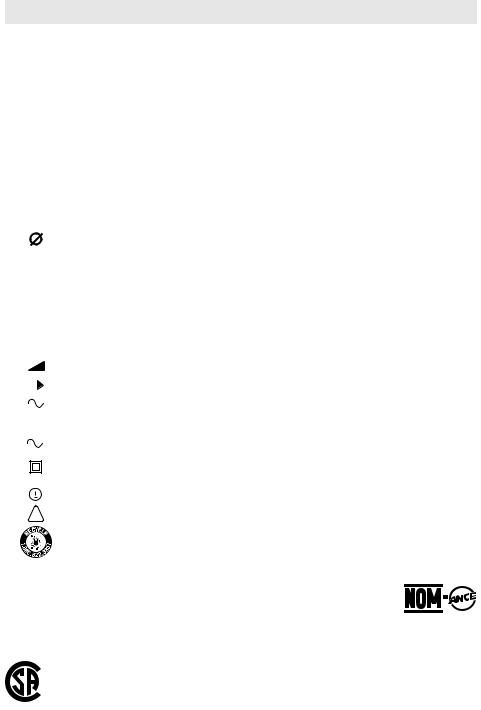
Symbols
IMPORTANT: Some of the following symbols may be used on your tool. Please study them and learn their meaning. Proper interpretation of these symbols will allow you to operate the tool better and safer.
Symbol |
Name |
Designation/Explanation |
||||||||
|
|
|
|
V |
Volts |
Voltage (potential) |
||||
|
|
|
|
A |
Amperes |
Current |
||||
|
|
Hz |
Hertz |
Frequency (cycles per second) |
||||||
|
|
|
W |
Watt |
Power |
|||||
|
|
|
kg |
Kilograms |
Weight |
|||||
|
min |
Minutes |
Time |
|||||||
|
|
|
|
s |
Seconds |
Time |
||||
|
|
|
|
|
|
|
|
|
Diameter |
Size of drill bits, grinding wheels, etc. |
|
|
|
n0 |
No load speed |
Rotational speed, at no load |
|||||
.../min |
Revolutions or reciprocation per minute |
Revolutions, strokes, surface speed, |
||||||||
|
|
|
|
|
|
|
|
|
|
orbits etc. per minute |
0 |
|
|
|
Off position |
Zero speed, zero torque... |
|||||
1, 2, 3, ... |
Selector settings |
Speed, torque or position settings. |
||||||||
I, II, III, |
|
Higher number means greater speed |
||||||||
0 |
|
|
|
|
|
|
Infinitely variable selector with off |
Speed is increasing from 0 setting |
||
|
|
|
|
|
|
|
|
|
Arrow |
Action in the direction of arrow |
|
|
|
|
|
|
|
|
|
||
|
|
|
|
|
|
|
|
|
Alternating current |
Type or a characteristic of current |
|
|
|
|
|
|
|
|
|
Direct current |
Type or a characteristic of current |
|
|
|
|
|
|
|
|
|
||
|
|
|
|
|
|
|
|
|
Alternating or direct current |
Type or a characteristic of current |
|
|
|
|
|
|
|
|
|
||
|
|
|
|
|
|
|
|
|
Class II construction |
Designates Double Insulated |
|
|
|
|
|
|
|
|
|
||
|
|
|
|
|
|
|
|
|
|
Construction tools. |
|
|
|
|
|
|
|
|
|
|
|
|
|
|
|
|
|
|
|
|
Earthing terminal |
Grounding terminal |
|
|
|
|
|
|
|
|
|
||
|
|
|
|
|
|
|
|
|
Warning symbol |
Alerts user to warning messages |
|
|
|
|
|
|
|
|
|
||
|
|
|
|
|
|
|
|
|
||
|
|
|
|
|
|
|
|
|
Ni-Cad RBRC seal |
Designates Ni-Cad battery recycling |
|
|
|
|
|
|
|
|
|
|
program |
|
|
|
|
|
|
|
|
|
|
|
This symbol designates that this tool is listed by Underwriters Laboratories.
This symbol designates that this tool is listed by the Canadian Standards Association.
This symbol designates that this tool is listed to Canadian Standards by Underwriters Laboratories.
This symbol designates that this tool is listed by Underwriters Laboratories, and listed to Canadian Standards by Underwriters Laboratories.
This symbol designates that
this tool complies to NOM Mexican Standards.
-5-
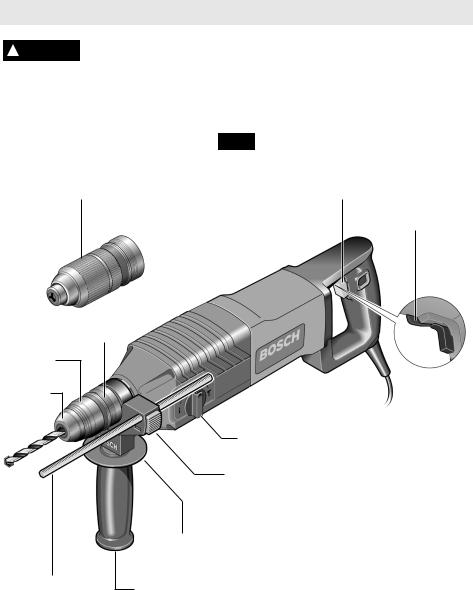
Functional Description and Specifications
Disconnect the plug from the power source before making any ! WARNING assembly, adjustments or changing accessories. Such preventive safety
measures reduce the risk of starting the tool accidentally.
Rotary Hammer
FIG. 1
3-JAW CHUCK
LOCKING
RING
LOCKING
SLEEVE
DUST
SHIELD
DEPTH
GAUGE
TRIGGER
SWITCH
REVERSING
SWITCH LEVER
 RELEASE BUTTON
RELEASE BUTTON
SELECTOR DIAL
SELECTOR DIAL
DEPTH GAUGE
RELEASE BUTTON
AUXILIARY
HANDLE
HAND GRIP
Model number |
11224VSRC |
Shank style |
SDS-plus® |
Maximum Capacities: |
|
Carbide tipped bits |
7/8" |
Thin wall core bits |
2-1/2" |
-6-
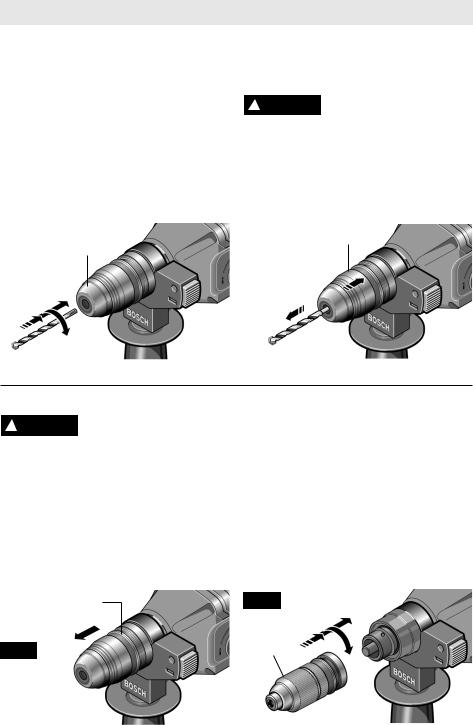
Operating Instructions
INSTALLING SDS-plus® ACCESSORIES
Clean the insert shank end of the accessory to remove any debris, then lightly grease with a light oil or lubricant
Insert accessory into the tool holder through the dust shield, while twisting and pushing inward until it locks automatically into place. Pull outward on the accessory to be certain it is locked into the tool holder (Fig. 2).
NOTE: The high efficiency available from the rotary hammers can only be obtained if sharp and undamaged accessories are used. The "cost" to maintain sharp and undamaged
FIG. 2 |
DUST |
|
|
|
SHIELD |
accessories is more than offset by the "time saved" in operating the tool with sharp accessories.
REMOVING SDS-plus® ACCESSORIES
! Accessories may be hot after WARNING use. Avoid contact with skin
and use proper protective gloves or cloth to remove.
To remove an accessory, pull and hold locking sleeve backward and pull bit forward. All accessories should be wiped clean after removing (Fig. 3).
|
LOCKING |
|
FIG. 3 |
||
SLEEVE |
||
|
CHANGING THE CHUCK
Do not carry the tool by the ! WARNING chuck. Tool may unexpectedly
fall if the chuck is not fully engaged.
The SDS-plus chuck can easily be exchanged for the 3-jaw chuck supplied with you tool.
Hammer drilling and chiseling are only possible when using the SDS-plus chuck with SDS-plus shank accessories.
The 3-jaw chuck converts your tool for use with a variety of straight shank bits for drilling and driving.
LOCKING RING
FIG. 4
REMOVING THE SDS-plus® CHUCK
Grasp the locking ring of the SDS-plus chuck and pull forcefully in direction of arrow and remove from tool (Fig. 4).
ATTACHING THE 3-JAW CHUCK
Grasp the 3-jaw chuck firmly with your hand and push it onto the tool with a twisting motion until you hear it lock into place (Fig. 5).
Pull outward on the chuck to be certain it is locked into the tool.
FIG. 5
3-JAW CHUCK
-7-
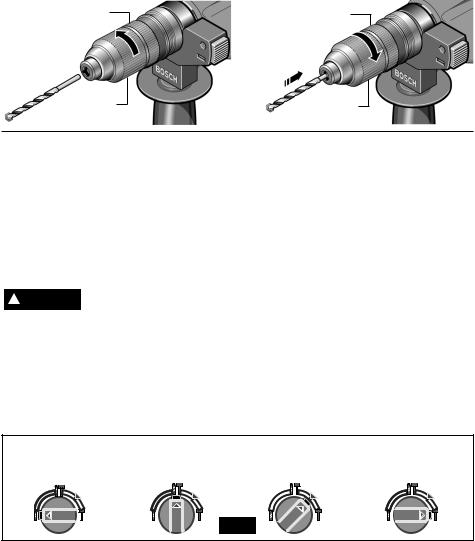
INSTALLING ACCESSORIES
3-JAW CHUCK
Hold chuck collar with one hand and rotate chuck sleeve in direction of arrow with the other hand until the jaws are open (Fig. 6).
For small bits, open jaws enough to insert the bit up to the flutes. For large bits, insert the bit as far as it will go.
Insert bit, hold the chuck collar with one hand and rotate chuck sleeve in direction of arrow with the other hand until it latches. Then clamp the accessory by continuing to turn the chuck sleeve forcefully in direction of arrow until you hear a ratcheting sound (Fig. 7).
|
CHUCK |
|
FIG. 6 |
||
COLLAR |
||
|
CHUCK
SLEEVE
Note: If after opening the chuck completely you hear a ratcheting sound when closing, simply open it a quarter turn and then resume closing the chuck. The ratcheting sound will stop.
REMOVING ACCESSORIES
3-JAW CHUCK
To remove a accessory, hold chuck collar with one hand and rotate chuck sleeve in direction of arrow with the other hand until the accessory can be removed (Fig. 6).
FIG. 7 |
CHUCK |
|
COLLAR |
|
CHUCK
SLEEVE
VARIABLE SPEED CONTROLLED
TRIGGER SWITCH
Your tool is equipped with a variable speed trigger switch. The tool can be turned "ON" or "OFF" by squeezing or releasing the trigger. The speed can be adjusted from the minimum to maximum nameplate RPM by the pressure you apply to the trigger. Apply more pressure to increase the speed and release pressure to decrease speed.
REVERSING SWITCH LEVER
The reversing switch lever is ! CAUTION located above the trigger
switch and is used to reverse rotation of the bit.
The reversing switch should only be activated when the motor is "OFF" and when bit is at a complete standstill.
To use tool in "Forward" rotation move lever to left side of tool, to "Reverse" the rotation of the bit move the lever to the right side of the tool.
SELECTOR DIAL
The selector dial allows the tool to be set for various applications as listed in the chart (Fig. 8).
! CAUTION |
Do not operate the |
|
selection dial until the tool |
||
|
come to a complete stop. Shifting during rotation of the chuck can cause damage to the tool.
SELECTOR DIAL - “VARIO-LOCK”
Adjusting the Vario-Lock: The vario-lock can be set in any one of thirty-six (10˚ increments) positions. Choose a position which is best suited for your operation.
Depress release button and turn the selector dial, to the “vario-lock” setting. Next, rotate the locking sleeve, along with the accessory, to the desired position. Then turn the selector dial to the “hammer only” setting and slightly turn the locking sleeve to have it automatically lock into a definite position.
Drilling only: |
Drilling/hammering: |
Vario-lock |
Hammering only: |
||||||||
used for drilling |
used for drilling |
allows for 36 desired |
used for light |
||||||||
wood, steel, etc. |
concrete |
positions of “hammer” |
chipping work |
||||||||
|
|
|
|
|
|
|
|
|
|
|
|
|
|
|
|
|
|
|
|
|
|
|
|
FIG. 8
-8-
SLIP CLUTCH
The tool has a internal pre-set slip clutch. The output spindle will stop rotating if the accessory binds and overloads the tool.
AUXILIARY HANDLE
The tool must be supported with the auxiliary handle, which can be swiveled 360˚. To reposition and/or swivel the handle, loosen the hand grip, move the handle to the desired position along the barrel and securely retighten the hand grip.
DEPTH GAUGE
Your drilling depth can be pre-set and/or repeated by using the depth gauge.
Setting depth: After the auxiliary handle is installed, make sure the accessory has been fully inserted into the tool holder before setting the depth gauge (Fig. 1).
To adjust depth, push the depth gauge release button, slide the depth gauge to desired depth and release pressure on button to lock the depth gauge in place.
TOOL TIPS
Following a few simple tips will reduce wear on the tool and the chance of injury to the operator.
The high efficiency available from the BOSCH Rotary Hammer can only be obtained if sharp and undamaged drilling tools are used. Note that the costs for maintaining sharp drilling tools are more than offset by the time lost in operating dull drilling tools.
All grease packed hammers require a short time to warm up. Depending on the temperature, this time will vary from approximately 15 seconds (90° F) to 2 minutes (32° F). The tool will exert its full power and hammering action after the heat from impact hammering has spread, softening the grease.
CARBIDE TIPPED BITS
Used for drilling stone, concrete, cement, brick, cinder block and other unusually hard non-metals. The Rotary Hammer is designed for “SDS” Carbide Tipped Bits up to 3/4 inch diameter.
3 JAW CHUCK
The 3 Jaw Chuck can convert your tool for use with straight shank bits.
You will extend the life of your bits and do neater work if you always put the bit in contact with the workpiece BEFORE pulling the
trigger. During operation, hold the drill firmly and exert moderate, steady pressure. Too much pressure at low speed will stall the hammer. Too little pressure will keep the bit from cutting and cause excess friction by sliding over the surface. This can be damaging to the drill and bit.
Shanks of all drill bits should be wiped clean prior to using and immediately after removing.
RECALL THESE INSTRUCTIONS FOR
SAFE OPERATION:
1.Some materials require slow drilling speeds; whereas, others require higher speed to produce the best results.
2.All work must be supported or secured before drilling and steady, even pressure applied in line with the drill bit.
3.As the drill bit cuts through the opposite side, reduce the pressure and continue running the drill as the bit is withdrawn.
Materials such as glass, porcelain, ceramics, tiles, plastics, etc., should be drilled at low speeds with specially designed drill bits and lubricants.
DRILLING WOOD OR PLASTIC
If backing block is not used, ease up on the pressure just before the bit breaks through the wood to avoid splintering. Complete the hole from the opposite side immediately after the point breaks through. If bit binds, reverse the drilling operation to help remove the bit from the work.
DRILLING METAL
Make a center punch in the material for easier starting. Use enough pressure to keep the bit cutting. If the bit is allowed to merely spin in the hole, it will become dull within a short time. When drilling a larger hole, it is faster and easier on your power pack to first make a smaller hole and enlarge it to the required size. Lubricate the tip of the bit occasionally with CUTTING OIL for easier metal drilling. If bit binds, reverse the drilling to help remove the bit from the work.
DRILLING MASONRY
Use carbide-tipped SDS-plus® bit for cinder block, mortar, common brick, soft stone and other materials. The amount of pressure to be used is dependent upon the type of material being drilled. Soft materials require less pressure while the hard materials need more pressure to prevent the drill bit from spinning.
-9-
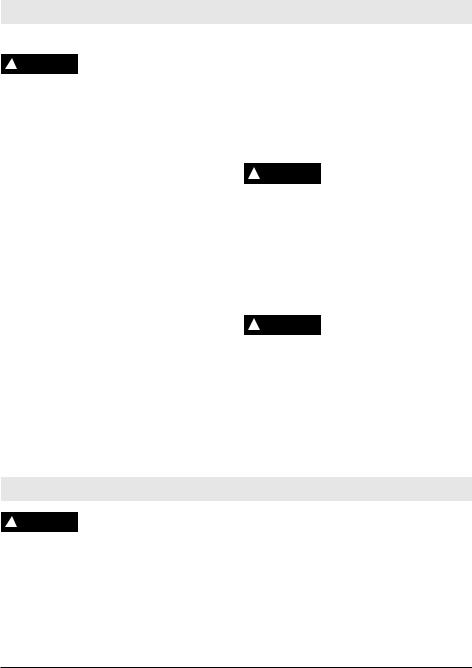
Maintenance
Service
! WARNING Preventive maintenance performed by unauthorized personnel may result in misplacing
of internal wires and components which could cause serious hazard. We recommend that all tool service be performed by a Bosch Factory Service Center or Authorized Bosch Service Station.
TOOL LUBRICATION
Your Bosch tool has been properly lubricated and is ready to use. It is recommended that tools with gears be regreased with a special gear lubricant at every brush change.
CARBON BRUSHES
The brushes and commutator in your tool have been engineered for many hours of dependable service. To maintain peak efficiency of the motor, we recommend every two to six months the brushes be examined. Only genuine Bosch replacement brushes specially designed for your tool should be used.
BEARINGS
Every second brush change, the bearings should be replaced at Bosch Factory Service Center or Authorized Bosch Service Station. Bearings which become noisy (due to heavy load or very abrasive material cutting) should be replaced at once to avoid overheating or motor failure.
Cleaning
To avoid accidents always ! WARNING disconnect the tool from
the power supply before cleaning or performing any maintenance. The tool may be cleaned most effectively with compressed dry air. Always wear safety goggles when cleaning tools with compressed air.
Ventilation openings and switch levers must be kept clean and free of foreign matter. Do not attempt to clean by inserting pointed objects through openings.
Certain cleaning agents ! CAUTION and solvents damage
plastic parts. Some of these are: gasoline, carbon tetrachloride, chlorinated cleaning solvents, ammonia and household detergents that contain ammonia.
Accessories
! WARNING If an extension cord is necessary, a cord with
adequate size conductors that is capable of carrying the current necessary for your tool must be used. This will prevent excessive voltage drop, loss of power or overheating. Grounded tools must use 3-wire extension cords that have 3-prong plugs and receptacles.
NOTE: The smaller the gauge number, the heavier the cord.
RECOMMENDED SIZES OF EXTENSION CORDS 120 VOLT ALTERNATING CURRENT TOOLS
Tool’s |
Cord Size in A.W.G. |
Wire Sizes in mm2 |
|||||||
|
|
|
|
|
|
|
|
||
Ampere |
|
|
|
|
|
|
|
|
|
Cord Length in Feet |
Cord Length in Meters |
||||||||
Rating |
|||||||||
25 |
50 |
100 |
150 |
15 |
30 |
60 |
120 |
||
|
|||||||||
3-6 |
|
|
|
|
|
|
|
|
|
18 |
16 |
16 |
14 |
0.75 |
0.75 |
1.5 |
2.5 |
||
6-8 |
18 |
16 |
14 |
12 |
0.75 |
1.0 |
2.5 |
4.0 |
|
8-10 |
18 |
16 |
14 |
12 |
0.75 |
1.0 |
2.5 |
4.0 |
|
10-12 |
16 |
16 |
14 |
12 |
1.0 |
2.5 |
4.0 |
— |
|
12-16 |
14 |
12 |
— |
— |
— |
— |
— |
— |
|
|
|
|
|
|
|
|
|
|
|
* Auxiliary Handle |
(*= standard equipment) |
* Carrying case |
(**= optional accessories) |
-10-
